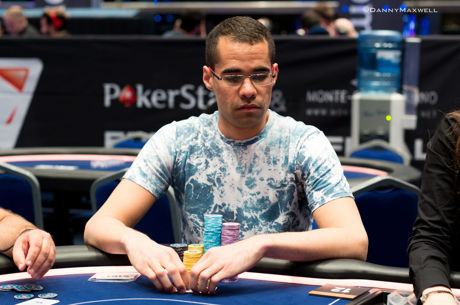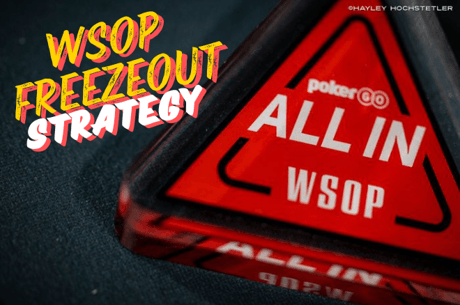WSOP Tells: Analyzing Examples of William Kassouf's Table Talk (VIDEO)

In the first part of this article, we looked at some general verbal patterns of William Kassouf, a talkative player at this year's 2016 World Series of Poker Main Event. In this follow-up, we'll look at a video of four hands and see how those general concepts played out in the real world.
Some hands
The video below has three value-bet hands where Kassouf makes several weak-hand statements and one bluff:
- the hand where he raise-shoves on the turn with a straight flush
- the hand where he three-bets pre-flop with A?A?
- another hand three-betting with K?K?
- the "nine-high like a boss" river bluff
Below the video I'll do some analysis of some of Kassouf's table talk or "speech play" in each of the hands.
Analysis: Turn raise with straight flush
In Kassouf's hand versus Stacy Matuson where he shoved the turn board of A?7?8?5? while holding 9?6? for a straight flush, here are the most interesting and probably meaningful statements he makes before and after the shove:
- "You going to keep bluffing me?" Kassouf says this before shoving. By implying that he thinks his opponent might be bluffing, followed by shoving, Kassouf weakens his perceived range.
- "You want to gamble, young lady? Yes or no." Kassouf asks this question in several ways before shoving. Saying things like "let's gamble" when betting a strong hand is a pretty common pattern, but it's such an often-heard phrase that better players are also capable of doing it with weak hands. This was one of two hands I saw where Kassouf used a phrase like "let's gamble" when betting or raising; the other one was when he three-bet with pocket aces. In this straight-flush hand he says "gamble" more than 14 times.
- "I can't call. There's only one million in the pot you only have six or seven [hundred thousand] behind." Kassouf says this as an apparent explanation for why he'd shove instead of calling. (Matuson informs him she actually has 900,000 behind.) When an average recreational player makes excuses for his actions, it will usually be a misdirection from the true reasons for his decision. While this can sometimes seem almost too obvious to be true, it will usually be true.
- "I know what she has anyway: she's got top pair with a heart draw." Kassouf says this after shoving and talking to Matuson for a while. Stating that an opponent has a weak hand is a goading behavior. It also, after a bet, implies some comfort with the situation. In this context, a single pair seems pretty weak on a three-flush board.
- "You playing to ladder up or you playing to win? I'm playing to win so I play for it all." This is both goading and a weak-hand statement. Kassouf is reminding Matuson that in a tournament you have to be willing to take chances to win. And he's implying that he's willing to take chances, to get his money in in questionable spots, in order to try to win.
- "You're probably ahead." Kassouf says this in a couple spots. It's rare for a bluffer to say such a direct weak-hand statement like this.
Analysis: Three-bet with pocket aces
Kassouf gets A?A? and three-bets Tony Gregg. Here are some of the statements he makes as he does:
- "Tony, Tony, Tony, every time it's Tony. Tony this, Tony that. 110. (referring to Gregg's raise) Marvelous. (sighs)." Said before his three-bet. This is akin to what I talked about earlier: a player who draws attention to an opponent's aggressiveness in order to weaken his own range. By drawing attention to the fact that Gregg is an aggressive opponent who raises a lot, Kassouf hopes to make his own three-bet seem lighter. Also the sarcastic "marvelous" and the sigh express sadness with the situation, which are both forms of weak-hand statements.
- "You made it 110 last time, right? I got to be consistent. You make it 110, I got to make it 260." I haven't mentioned it thus far, but calling attention to past hands or situations is correlated with relaxation, especially if that past situation was where the speaker was weak. Bluffers don't like to talk about prior spots in the hand or previous hands, as they are genuinely nervous their opponent might read into their talk in ways they don't expect. Here's a blog post I wrote about a hand from the PokerStars Big Game show demonstrating a similar reference back to an earlier hand.
- "Find out where I am." This is a pretty commonly heard misdirection. It's actually so commonly understood as a tell for strength that it is fairly often used as a false tell by players who bluff or semi-bluff early in a hand.
- "No shame in folding." This is a bit goading.
- "You play to win, right? You won the One Drop. You play for it all. You're not going to play to ladder." Similar to what he said to Matuson in the straight flush hand, this is referencing the idea that you have to take risks to win a tournament. It's also a bit goading.
- "We can gamble, get it all in. You know me, I like to gamble with the nuts." More references to "gamble," as in the last hand. I'm not entirely sure, but I think Kassouf's statement that he "likes to gamble with the nuts" means that the other person has the nuts, which would make this a weak-hand statement. (I initially thought he was saying jokingly that he liked to gamble when he himself had the nuts, though I changed my mind.) He said this same phrase in a couple other televised hands, including the straight-flush one.
Worth mentioning here �� in both of these past two hands, along with these weak-hand statements, there were many standard strong-hand statements thrown in, mostly part of Kassouf's standard strong-hand repertoire. But we are focused on the weak-hand statements, as those are the ones that are mostly missing from when he is bluffing or vulnerable.
Analysis: Three-bet with pocket kings
Wesley Brockhoeft raises and Kassouf 3-bets with K?K?.
- "Standard button raise, right? Any two? Are you just gambling with the nuts today?" More implying weakness about an opponent's hand.
- "Let me ask you one question: you want to play a big pot or a small pot? Up to you. If you don't say anything I'll have to raise you. Oh, I think I'm ahead then. You look nervous. Let's find out where I am. Raise it up." This is a misdirection, implying that the reason Kassouf is raising is because his opponent is not answering him, or because he looks nervous.
- "If you got it you got it." Another commonly-heard weak-hand statement from players with strong hands. Similar to "find out where I am," it's well understood enough that experienced players sometimes use this as a reverse tell when betting weak hands.
- "Don't fold just yet. Have to make it look like you have a big hand before you lay it down." Said after Kassouf has three-bet and his opponent is thinking. Very goading behavior. It would be very rare for a bluffer to say this, as it's conceivably possible it might trigger a frustrated or angry shove.
Analysis: "Nine-high like a boss" river bluff
In this hand, Kassouf bluffs the river versus Matuson. His speech is very restrained here. He mainly makes standard strong-hand statements and neutral statements, as he does in most other standard spots in the broadcast, including a couple bluffing spots.
Statements include:
- "There's over 600K in there, so I want you to call."
- "If you fold, I'll show, but I want you to call 100 percent."
- "Well, the decision's on you, young lady, you don't need to go on about it." Kassouf said this after Matuson complained about Kassouf's talking. This was a surprisingly goading response from Kassouf. Kassouf did show himself able to make a couple fairly goading statements when bluffing, including how he called the clock on his opponent when he bluffed his counterfeited nines on the river.
- "Don't want to bust out with the whole camera crew watching. That will be embarrassing." Instead of drawing attention to how you "have to gamble to win" a tournament, here Kassouf is drawing attention to the negative aspect of gambling.
- "You don't put me on this hand, I'll tell you." Implying strength.
- "I'm not trying to bust you." This is a pretty conciliatory statement. These kinds of statements are much different than the "let's gamble" kind of statements and goading statements seen in previous hands. Oftentimes bluffers, if they are set on talking, will talk but do so in very friendly, conciliatory ways.
Conclusions
Admittedly the hands featuring Kassouf's talking are a small sample size. There were only a few hands during which he was seen talking at length. Adding to the difficulty in interpreting his behavior is that, at one point in the event, the floor people told Kassouf to stop talking at all when it was his opponents' decision, something that could have affected the amount and nature of his talking after that point.
Still, I am confident I've pinpointed a verbal imbalance that Kassouf has of being more likely to do a couple things when he's betting/raising with a strong hand:
- Make weak-hand statements in various forms
- Make goading statements
I feel confident not only based on the few hands I've seen but also based on my research in writing Verbal Poker Tells and my confidence that these are patterns that are common in the general player population.
This is not to say that these patterns are 100% reliable. There are variations and outliers amongst the general population and for Kassouf himself. It can be hard when someone makes a single statement and is otherwise quiet.
But when you have multiple general tells leading in one direction, as you do in all of these Kassouf value-bet examples, it does add up to paint a pretty reliable picture. This analysis does show the downsides of talking a lot during hands. It is more difficult than most people realize to stay balanced and not have some sort of pattern show up when you do a lot of talking like Kassouf does.
At the same time, I do want to say, in Kassouf's defense, that even if he were definitely imbalanced, it does not necessarily mean that Kassouf was making bad choices, or that he was unaware of the imbalance. Theoretically, Kassouf could have been choosing his spots carefully and saying what he thought was likely to get a fold from his opponent in that specific situation.
As a way of illustrating this, you can find examples of imbalances in Daniel Negreanu's talking, but this is because Negreanu chooses his spots and tries to manipulate amateur players into doing what he wants. He would not choose the same strategies against more skilled opponents. I think this is important to note in order to leave open the possibility that Kassouf was more aware of verbal tells than you'd guess from his evident imbalances.
This week, I recorded a podcast with The Poker Guys, talking about Kassouf's "speech play" and verbal tells in general. If you found these articles interesting, I think you'll enjoy the discussion we had. Here's?a link to that podcast.?
Zachary Elwood is the author of Reading Poker Tells and Verbal Poker Tells, and the creator of a poker tells video series (www.readingpokertells.video). Follow him on Twiitter @apokerplayer.









